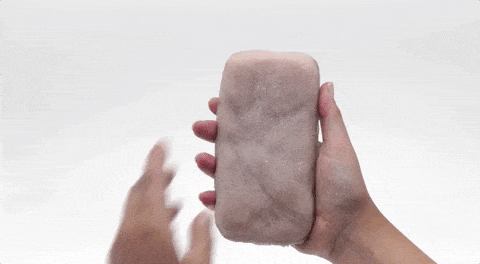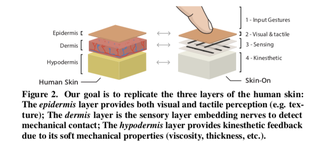 When your friend texts “lol,” how can you be sure they’re really laughing at your joke? Well, here’s one way to know for sure: a new phone accessory that you can tickle, which releases a laughing emoji afterward.
When your friend texts “lol,” how can you be sure they’re really laughing at your joke? Well, here’s one way to know for sure: a new phone accessory that you can tickle, which releases a laughing emoji afterward.
That’s weird on its own, but then there’s this horrifying wrinkle: The phone case is made of artificial skin.
Thankfully, the bizarre accessory isn’t really a thing in stores, nor are there immediate plans for it to be. Instead, it’s part of a new study by researchers at the University of Bristol, Sorbonne University, and École Polytechnique, who all wanted to experiment with input-based gestures.
In the paper, made public today, the researchers dig into these so-called “Skin-On Interfaces” in four main ways: how to reproduce the look and feel of human skin; how gestures performed on skin can be used in the interfaces; how devices can recognize gestures input on the skin; and how others can reproduce the research.
This is part of a bid to “increase interaction bandwidth,” according to the study authors. Their goal is to make electronic communication more accessible by utilizing haptic feedback that people are familiar with in their own sensory experiences. For example, the back of a cell phone could be covered in artificial skin to sense unique user gestures like grabbing, twisting, and scratching to provide tactile feedback. The researchers say this could increase user expressiveness.
Next-Level Human-Computer Interaction
This isn’t the first foray the field of robotics has taken into skin technology. The entire study of human-computer interaction is dedicated to bridging the gap between new technology and our organic makeup.
Researchers study topics like flexible robotics to make more user-friendly helpers in the health care world, for example. At Carnegie Mellon University, robotics professor Chris Atkeson even worked on flexible robots that eventually led him to work with Pixar in designing the big, friendly Baymax character in the film Big Hero 6.
A separate team of researchers created artificial skin made from electroactive dielectric elastomer—a soft, compliant smart material—to effectively copy the action of biological chromatophores, the small, pigmented cells that cephalopods use to change their skin texture and color.
In another instance, researchers working on a Windows application called PhysiOBS used skin conductance to measure and communicate stress levels.
And at Stanford, researchers created artificial skin somewhat similar to the skin device researchers’ own prototype. The difference: The Stanford skin was used to help robots “feel” through a form of haptic touch. Those researchers said the technique could be useful in human prosthestics.
The authors of the skin device research say these and other studies of skin in robotics have been applied mainly to cosmetics, sensing, and safety, rather than human-computer communication. Sometimes robots are given the ability to “feel” with skin to help them get around in an environment, but that information isn’t readily transmitted to an end-user.
“Artificial skin has been widely studied in the field of robotics but with a focus on safety, sensing or cosmetic aims,” Marc Teyssier, the lead author, said in a press statement. “This is the first research we are aware of that looks at exploiting realistic artificial skin as a new input method for augmenting devices.”
Skin in the Game
To make the skin look realistic, the team created a multilayer silicone membrane that’s supposed to mimic the multiple dermises of real human skin. There’s a textured layer on the outside that even has extremely detailed dimpling like the pores of our skin, an electrode layer of conductive “tissue,” made up of threads and a hypodermis layer. The researchers say this type of casing is more natural than the rigid ones we commonly see, resulting in a shell that can “feel” the user’s grasp from its pressure and location to specific sensations like tickling.
“The idea is perhaps a bit surprising, but skin is an interface we are highly familiar with so why not use it and its richness with the devices we use every day?” Dr. Anne Roudaut, associate professor in Human-Computer Interaction at the University of Bristol, said in the press release.
Because smartphones are mostly used for mediated communication through text, voice, and video, the researchers created a messaging app where users can express tactile emotions through the artificial skin. So if a user tickles the touch controls, it inputs a laughing face. The stronger the tickle is, the larger the emoji looks. Tapping, meanwhile, creates a surprised emoji.
The input methods include a skin phone case, mousepad, and smartwatch band.
“This work explores the intersection between man and machine,” Roudaut said. “We have seen many works trying to augment human with parts of machines, here we look at the other way around and try to make the devices we use every day more like us, i.e. human-like.”
So what’s the next step for the creepy, yet fascinating skin research? The team wants to make their skin even more realistic and is considering embedding hair and temperature feelings. Now that should give you goosebumps.
[“source=popularmechanics”]

